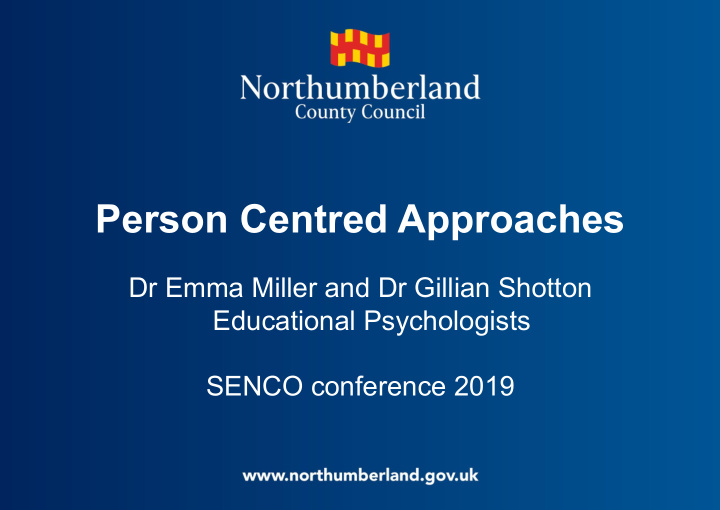



Person Centred Approaches Dr Emma Miller and Dr Gillian Shotton Educational Psychologists SENCO conference 2019
‘I like it when I’m asked if I understand’ ‘I like it when I’m asked if I understand’ ‘I have lot of input in my support plan’ ‘I have been involved with my pupil passport’ ‘Mostly teachers know about my needs’ I like it when I’m asked if I understand’ Quotes from Northumberland CYP obtained from a recent piece of work carried out by SENDIASS ‘I have lot of input in my support plan’ ‘I have lot of input in my support plan’ ‘I have been involved with my pupil passport’ ‘Mostly teachers know about my needs’ Quotes from Northumberland CYP obtained from a recent piece of work carried out by SENDIASS ‘I have been involved with my pupil passport’ ‘Mostly teachers know about my needs’ Quotes from Northumberland CYP obtained from a recent piece of work carried out by SENDIASS
Aims and Objectives – Background – What it is – Why use Person Centered – Facilitating a Person Centred Review – Helpful tools
What is Person Centred Planning? Person Centred Planning is not one defined process, but a range of processes all sharing the same underpinning values base and goal. Its aim is to help a person to move toward the life that they want and to get the right support in doing this.
Sharing Listening Power Person Centered Tools Person Centered Principles Person Centered Person Centered Reviews Planning Connecting Responsive with Action citizenship
Your experiences • What are your experiences of person centred working? – Reviews? – Planning? – Other ways of being person centred?
Why person centred? • Being person centred is an approach which puts the child/ young person and their family at the heart of the process and is meant to make a more relaxed, informal experience • It is founded on the belief that people should be in control of their lives and at the centre of any meeting held to decide the services they receive • The emphasis is on ensuring that everyone participates and has their say and their views are respected and recorded • Approach advocated throughout the SEN Code of Practice and the Children and Families Act 2014
Research: Advantages • Greater participation • Improved collaboration • Greater understanding of needs • Higher achievement of targets
Research: Barriers/difficulties • Too little focus on pupil’s difficulties • Time consuming • Facilitators and participants feeling daunted as not adequately prepared
What helps or makes it difficult • Experienced, skilled facilitator • Preparing participants • Writing in front of others may cause anxiety (White and Rae 2016) • Time
Person Centered Tools
Person Centred Reviews • Who is here? • What we like and admire about…..? • What is working well? • What is not working so well? • What is important to the child/YP now? • What is important to the child/YP in the future? • Action plan
A clear action plan • Does the action plan make you feel like you know the child /young person? • Does it give you enough information that you could support the child /young person well even in a new situation? • Is the plan written in everyday language that is inviting and easy to read, does it include words used by the participants? • Has the child / young person had an opportunity to shape what is said and what is shared?
Resources https://www.oldham.gov.uk/downloads/file/3779/send_gui dance_person_centred_planning_toolkit https://linwood.bournemouth.sch.uk/linwood/files/2018/05/ Person-Centred-Reviews-booklet.pdf https://inclusive-solutions.com/person-centred-planning/
References • Allen, J.D. (2003). Gay, Lesbian, Bi-sexual and Transgender People with Developmental Disabilities and Mental Retardation: Stories of the Rainbow Support Group. Routledge, Taylor and Francis Group • Buhin, L. & Vera, E.M. (2008). Preventing racism and promoting social justice • Dysart-Gale, D. (2010). Social justice and social determinants of health: Lesbian, gay, bisexual, transgendered, intersexed, and queer youth in Canada. Journal of Child and Adolescent Psychiatric Nursing, 23(1), pp.23-28. • Person-centered and environment-centered interventions. The Journal of Primary Prevention, 30(1), pp. 43-59.
• Callicot, K.J. (2003). Culturally sensitive collaboration within person-centered planning. Focus on Autism and Other Developmental Disabilities, 18(1), pp. 160-68. • Dowling, S., Manthorpe, J., & Cowley, S. (2007). Working on person-centred planning: From amber to green light? Journal of Intellectual Disabilities,11(1), pp. 65-82. • Flannery, K.B., Newton, S., Horner, R.H., Slovic, R., Blumberg, R. & Ard, W.R. (2000). The impact of person-centered planning on the content and organizations of individual supports. Career Development for Exceptional Individuals, 23(2), pp. 123-137. • O'Brien C.L & O'Brien J. (2000). The Origins of Person-Centered Planning: A Community of Practice perspective. Atlanta: Responsive Systems Associates, Inc.
• O-Brien, J. (2004). If person-centered planning did not exist, valuing people would require its invention. Journal of Applied Research in Intellectual Disabilities, 17(1), pp. 11-15. • Pearpoint J., O'Brien J. & Forest M. 1993. PATH: A workbook for planning positive, possible futures and planning alternative tomorrows with hope for schools, organizations, businesses and families. Toronto: Inclusion Press. • White and Rae (2016) Person Centred Reviews and Transition: An exploration of the views of the students and their parents/carers, Educational Psychology in Practice 32(1), 38-53
Recommend
More recommend